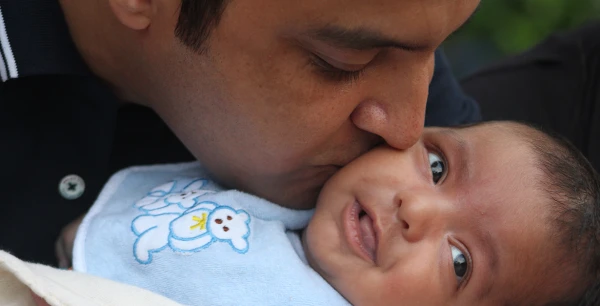 This article originally appeared on US News and World Report, January 13, 2017.
This article originally appeared on US News and World Report, January 13, 2017.Things to Consider Before Beginning Sleep Training
How is your baby sleeping now? Is your baby getting the adequate amount of sleep for their age and at the right times? Are they waking more than is expected for their age? Talk to your child’s doctor if you’re not sure.
Is what you’re doing sustainable? Some patterns will change with time – others won’t. Ask yourself if you can continue doing what you’re doing for the next six to 12 months.
Is your baby ready? Understand what is developmentally appropriate for your baby’s age. Sleep training is not recommended or supported for infants under 4 months. In fact, sleep training prior to 6 months has not been well researched. Further, at this age, an infant’s ability to self-soothe is limited. Developmental researchers Nathan Fox and Susan Calkins suggest that babies under 6 months have limited neurological capacities to calm themselves from more intense distress. In addition, developmental leaps, growth spurts and changing feeding needs can make sleep unpredictable and efforts to train difficult or unsuccessful. After 6 months, your baby will be more capable of self-regulation, and more ready for sleep success.
Are you ready? – Changing sleep patterns can sometimes result in things getting worse before they get better. It can take time and stamina. You will need to be committed to fully trying one thing for at least three to four days to see if there’s any improvement. The full process may take two to three weeks.
So you’ve asked the right questions. Now, ensure you’re prepared and take these steps to improve your likelihood of succeeding with sleep training:
Get a green light from the pediatrician. Make sure the child doesn’t have any health issues, such as acid reflux, sleep apnea or food allergies, that might make sleep training counterproductive.
Keep a sleep and feeding log. Pay attention to any patterns that emerge. Does your baby always wake at 1 a.m.? Do they go to sleep better at a certain time?
Make sure your baby gets adequate daytime sleep. Fill your baby’s daytime sleep tank as much as you can. Good daytime sleep makes for an easier bedtime and a more restful night.
Early to bed and early to rise. For young children, an early bedtime translates into better – and more – sleep. Try for a 7 or 7:30 p.m. “in bed” bedtime, and have a consistent 6 to 7:30 a.m. wake time so that daily routines are predictable.
RELATED: Why an Early Bedtime Means More Restful Sleep
Create a relaxing bedtime routine. Create a short sequence of simple activities that are soothing for your baby and that you follow consistently each night.
Create a good sensory sleep environment. White noise and room-darkening shades can help create an environment that’s conducive to sleep.
Make sure caregivers are on board. Consistency across all the baby’s caregiving settings can help ingrain new patterns more quickly.
Pick a realistic start date: Block out about three weeks where you can focus on sleep – with no planned houseguests, travel, or holidays.

Selecting a Sleep Training Approach
Now it’s time to choose a sleep training option. You’ll want to pick one that fits your values and your baby’s temperament, and that you can do consistently. Inconsistency due to second-guessing or ambivalence makes things worse and can lead to more tears in the long run.
Most published interventions are variations of either what’s called extinction – also known as crying it out or “Ferberizing” – or fading, gradually reducing the amount of parental intervention.
Crying it out: There are a few versions of extinction that appear in sleep books and articles. One is pure extinction, or “cold turkey” – putting your baby down and not returning until morning. Another approach is graduated extinction, which involves putting your baby down and returning at gradually longer intervals.
As major pro of extinction is that it can work fast. Many parents find that children are sleep trained within three or four nights. However, other parents have to keep at it for a week or more and, in some instances, babies cry for longer than five to 10 minutes at a time. Further, parents typically don’t like using it and may have a hard time staying consistent long enough for it to work. Some babies may cry a lot and not see improvements in sleep.
Fading: This approach focuses on gradually reducing the amount and frequency of parental intervention for a child to go to sleep or fall back asleep. Parents may start by soothing their baby by the crib while slowly reducing the soothing and, over the span of several days, move farther and farther away until the baby can settle on his or her own. (Note that fading is different from a process called “bedtime fading,” which involves gradually moving bedtime later in increments so that you can determine the optimal bedtime, and then moving it back to an earlier time when baby is sleeping well.)
Fading is easier on babies and easier on parents, making it more likely that parents will be able to follow through consistently. Fading can also be tailored to a variety of contexts, including room sharing and night nursing. A drawback is that it works a little more slowly than extinction. It can take eight to 12 nights, though parents can typically see improvement in five to seven days.
If you aren’t sure which choice is right for you, it’s okay to start with a gradual approach. Give it at least four or five days to see if any improvements occur. If you feel like things are moving too slowly and you have to speed things up – and your baby is the right age – you can always move to graduated extinction later. The key is to pick an intervention that feels right for your family, which you can commit to doing. A consistent, predictable approach to sleep that fits your family will pave the way for sleep success.


